Forest Biomass Energy Resources in China: Quantity and Distribution
Abstract
:1. Introduction
2. Data and Methods
2.1. Definition of Different Forest Biomass Energy Resources
2.2. Estimation of Wood Residues and Wood for Burning
| Abbr | Full Name | Content |
|---|---|---|
| WFBR | Wood Felling and Bucking Residue | Residue produced from the wood felling and bucking activities |
| WPR | Wood Processing Residue | Residue produced from the processing of different wood products |
| LWPR | Local Wood Processing Residue | WPR was estimated based on the assumption that the wood resource is only processed on the spot without wood transfer among provinces |
| AWPR | Actual Wood Processing Residue | WPR was estimated from the actual wood processing, including wood transfer among provinces and specific conversion parameters for different wood products |
| BPR | Bamboo Processing Residue | Residue produced from the processing of different bamboo products |
2.3. Data Source and Parameter Determination
| Category | Felling and Bucking | Converted Timber and Other Wood Products | Plywood | Other Wood Man-Made Board | Moso Bamboo and Artemisia Bamboo | Tiny Bamboo | Wood for Burning |
|---|---|---|---|---|---|---|---|
| Residue proportion | 1-ω | 0.58 | 0.5 | 0.1 | 0.6 | 0.6 | 1 |
| Equivalent weight coefficient | 1.17 (ρ1, ton m−3) | 0.9 | 0.9 | 0.9 | 5 | _ | 1.17 |
| (ρ3, ton m−3) | (ρ3, ton m−3) | (ρ3, ton m−3) | (ρ2, kgpiece−1) | (ρ1, ton m−3) |
2.4. Regional Division
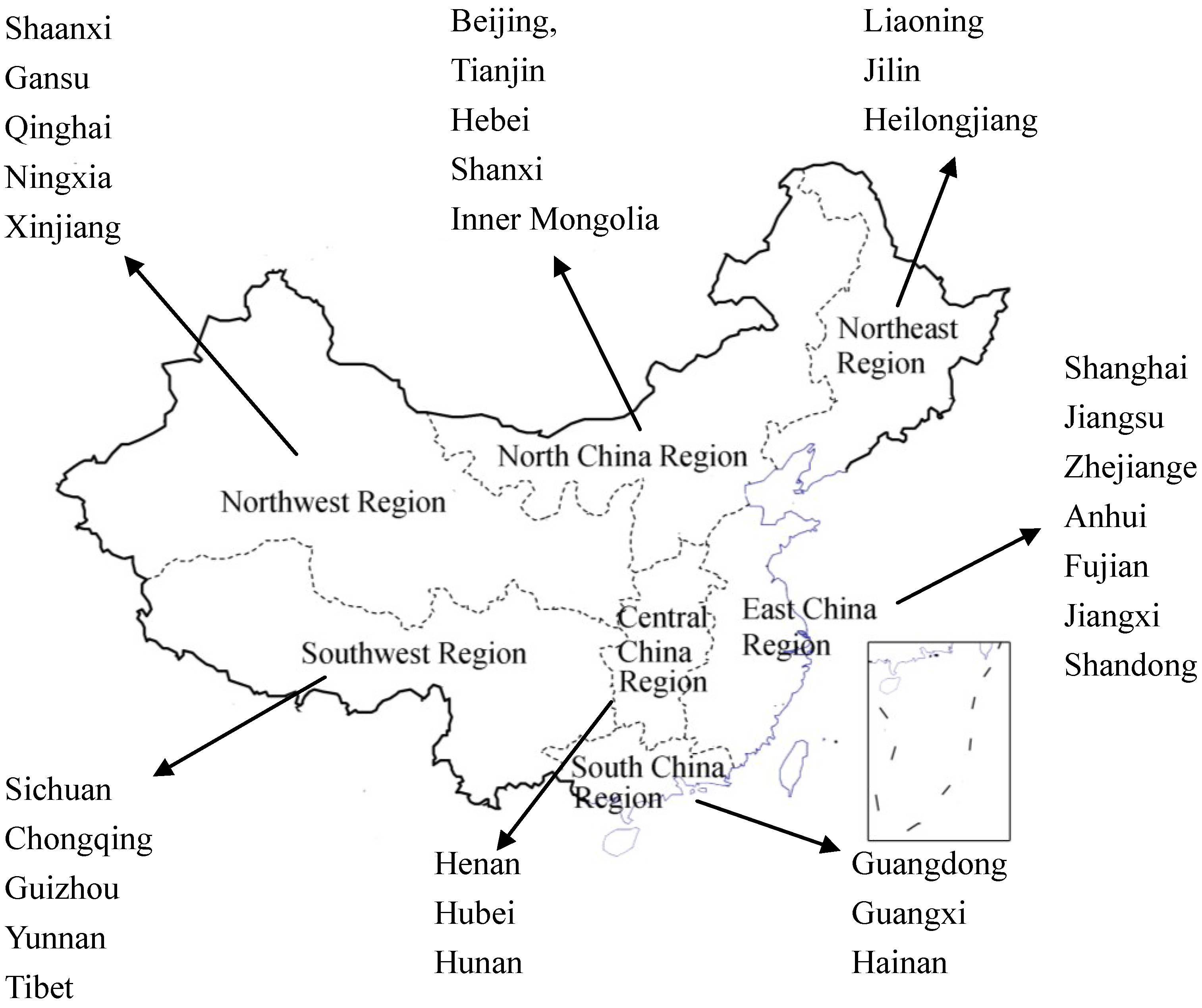
3. Results
3.1. Total Forest Biomass Energy Resourcesin China
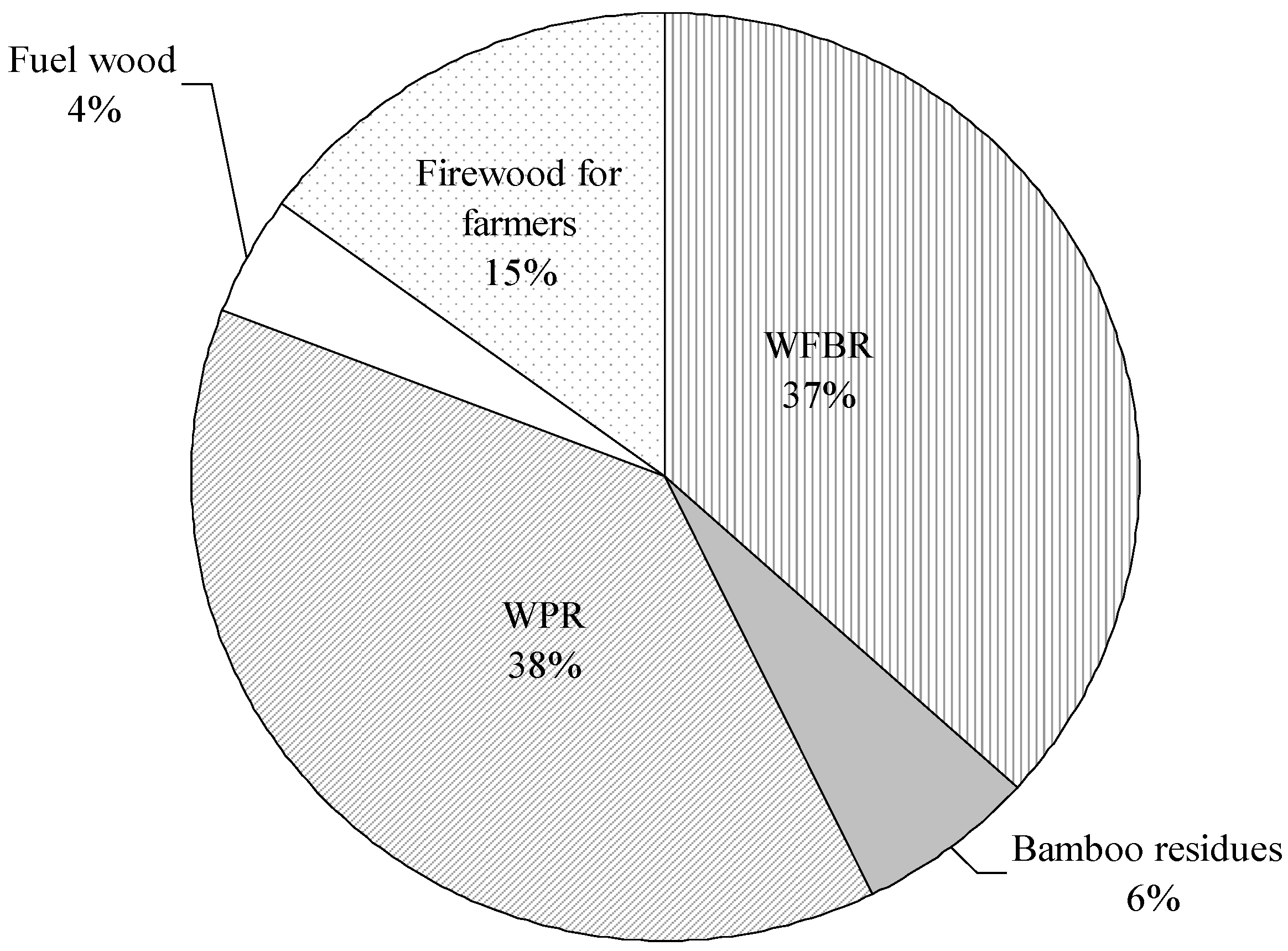
3.2. Forestry Biomass Energy Resources in Different Provinces
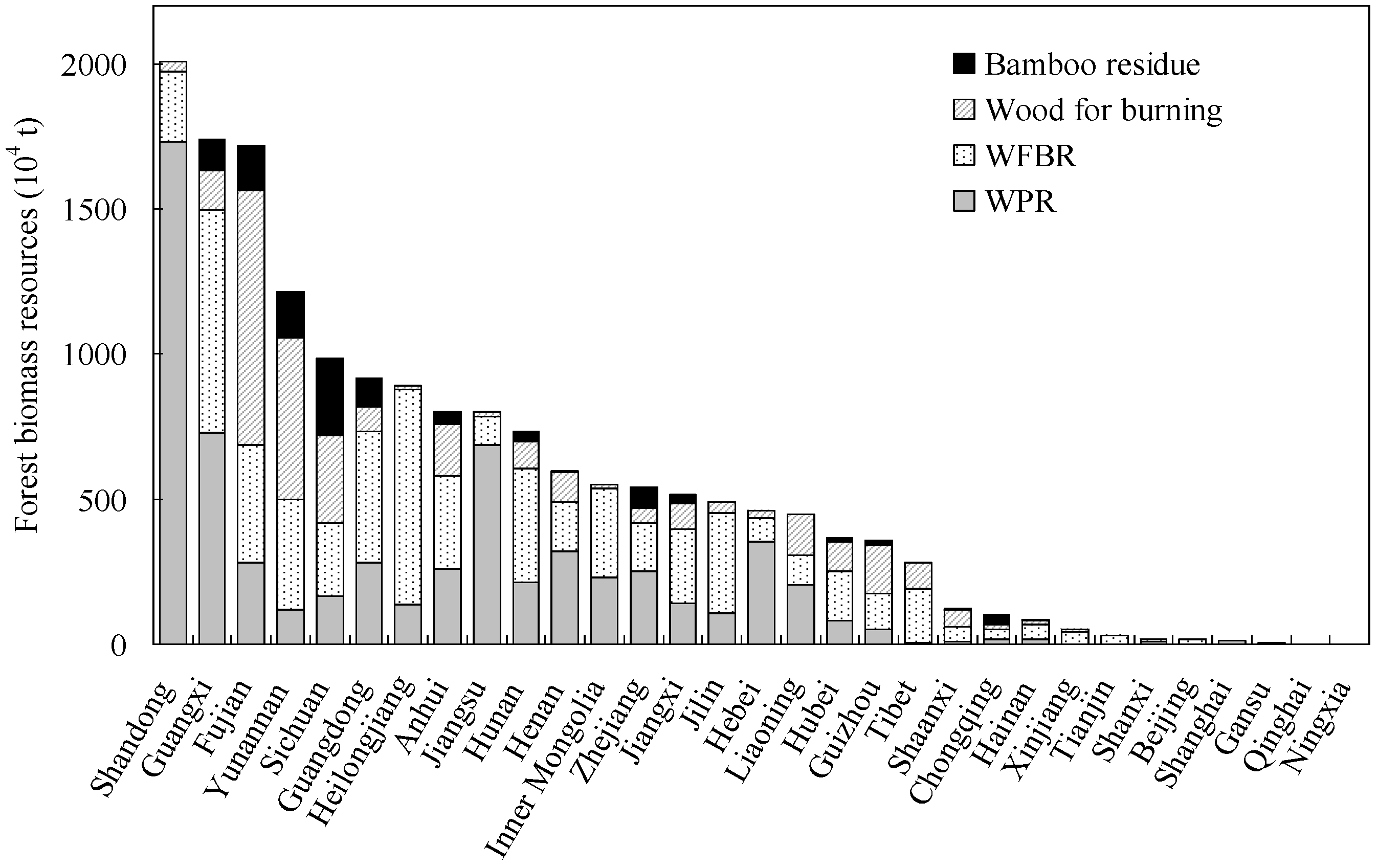
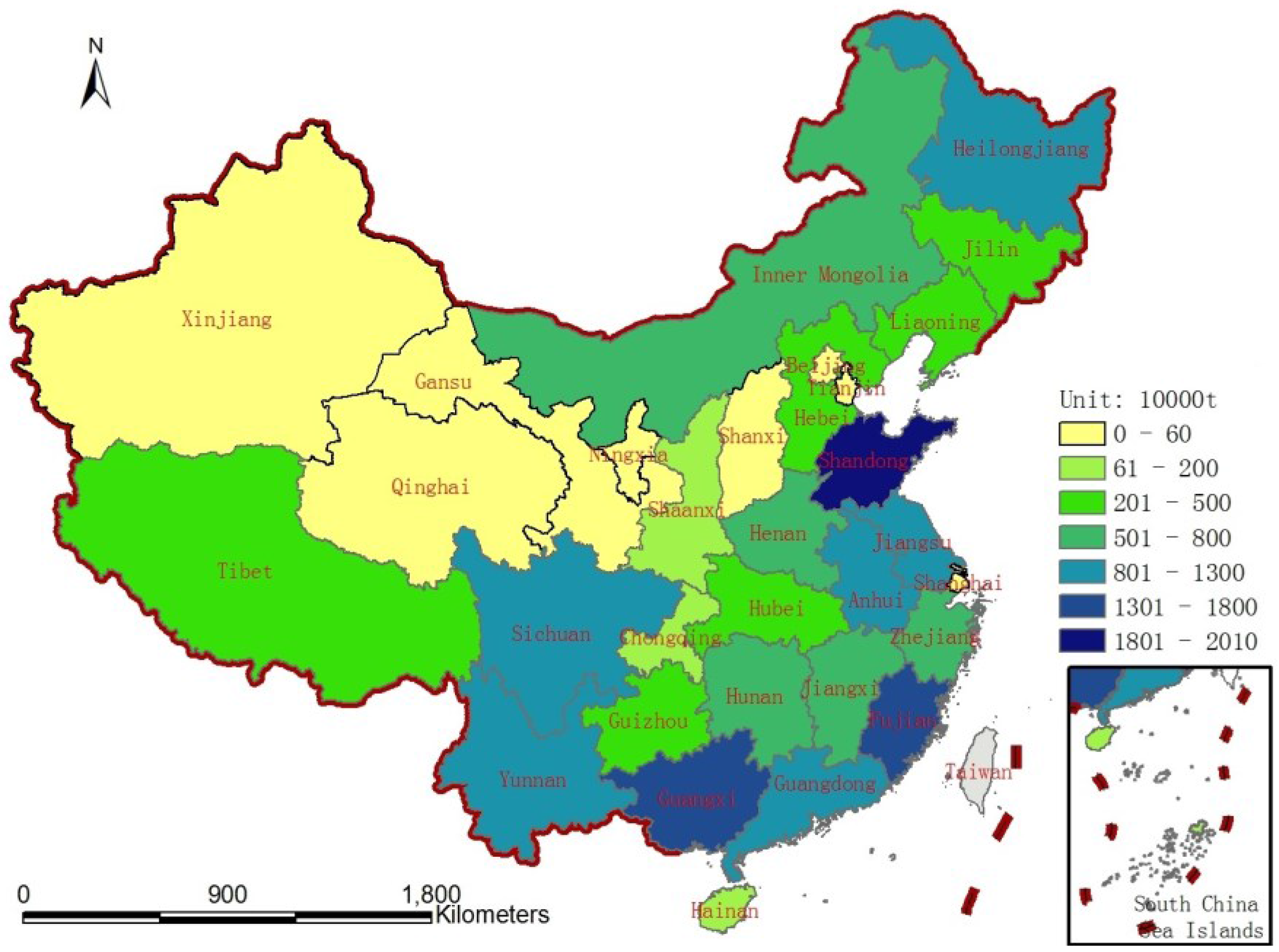
3.3. Contributions of Forestry Bioenergy Resources from Different Regions
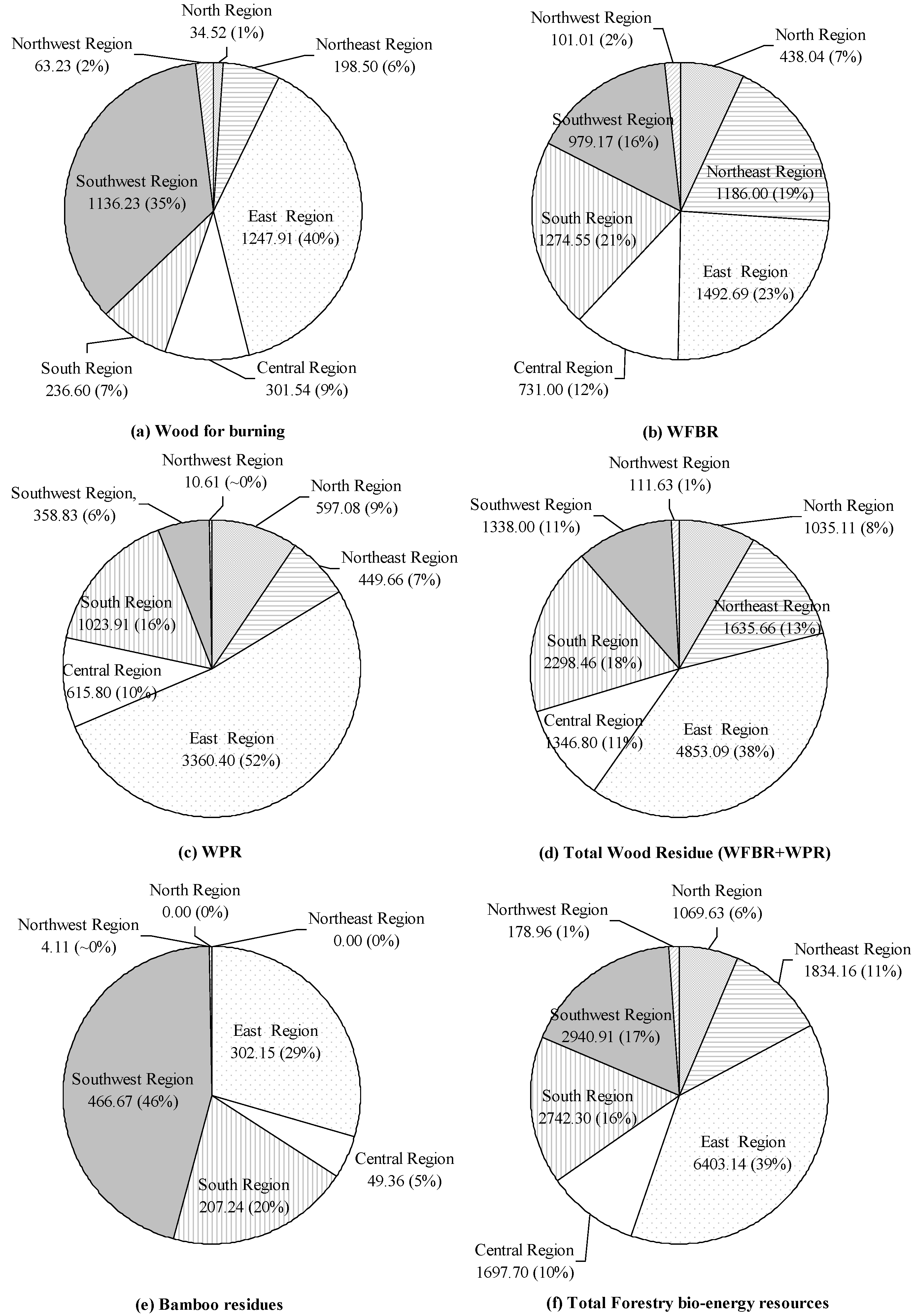
4. Discussion
4.1. Comparison of Estimations of Forest Biomass Energy Resources
| Literature | Resource Amount (108 t) | Data Source | Resources Category |
|---|---|---|---|
| Liu and Shen (2007) [6] | 2.91 | The 5th National Forest Resources Inventory Report | Firewood forest; forestry production harvesting, processing residue as well as tending and intermittent cutting of forest |
| Liao et al.,(2004) [22] | 2.27 | The 4th National Forest Resources Inventory Data | Timber forest, shelter belts, firewood forest, forest for special purpose, economic forest, woodland, shrub and orchard |
| Yuan (2005) [23] | 1.58 | No annotation | Annual rational harvest of timber |
| Chinese Forest Biomass Energy Research Group (2006) [20] | 3.0 | The 6th National Forest Resources Inventory Data | Firewood forest; forest harvesting surplus and tending and intermittent cutting of forest; economic forest, bamboo forest shearing and timber processing, shrub cutting and others. |
| Qian (2007) [13] | 2.11 | The 6th National Forest Resources Inventory Data | Harvesting afforestation, timber processing residue and waste timber |
| Yang et al., (2010) [21] | 4.99 | The 6th National Forest Resources Inventory Data | Firewood forest; forest harvesting, timber processing residue; tending and intermittent cutting of forest |
| Shi (2011) [7] | 1.25 | The 6th National Forest Resources Inventory Report | Timber harvesting, processing residue and afforestation residue |
| Zhou et al., (2011) [14] | 1.97 | The 7th National Forest Resources Inventory Data | Six forest resources of timber forest, shelter belts, firewood forest, forest for special purpose, economic forest, etc. |
| Cai, et al. (2012) [15] | 5.5 | The 6th National Forest Resources Inventory Data, National Forest Limited Cutting Amount and other Statistic Data | Forest growth residue (including shrubs, economic forest, urban greening, surrounding trees and woodland), forestry production residue (including forest harvesting, timber processing, scrap wood products, tending and intermittent cutting of forest and afforestation) and energy forest |
| This study | 1.69 | China Forestry Statistical Yearbook2010 | Forest harvesting, bucking and processing surplus; fuel wood; firewood cut and used by farmers, farmer self-used timber harvesting surplus |
4.2. Spatial Distribution of Forest Biomass Energy Resources
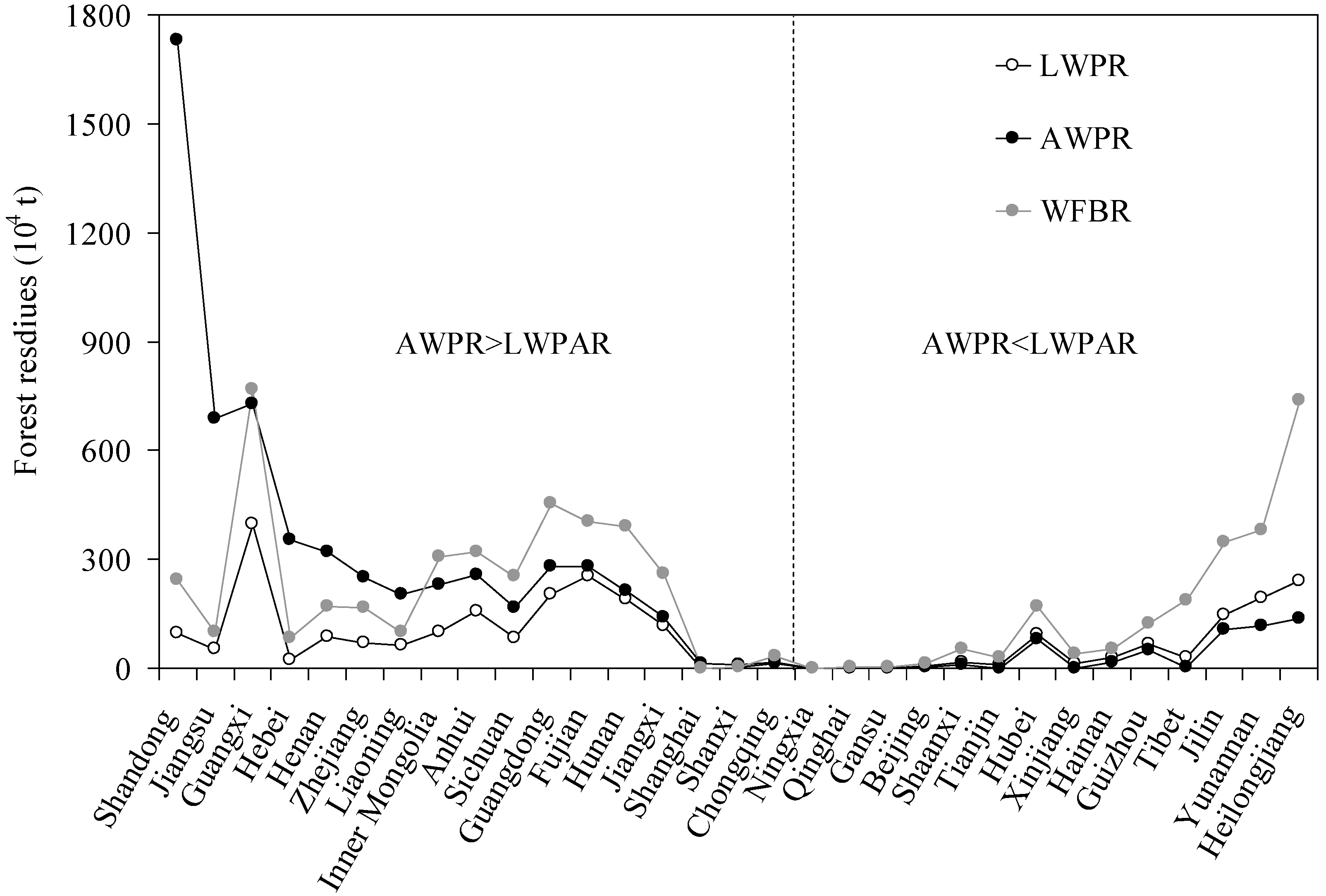
4.3. Potential of Forest Biomass Energy Resources in China
5. Conclusions
- (1)
- The total forest biomass energy resources in China were approximately 169 million tons in 2010, in which the wood processing residue (WPR), wood felling and bucking residue (WFBR), bamboo processing residue, fuel wood and firewood used by farmers accounted for 38%, 37%, 6%, 4% and 15%, respectively.
- (2)
- Wood for burning is mainly concentrated in East China and Southwest China, which accounted for nearly 3/4 of the total resource of wood for burning. Fujian and Yunnan have relatively more wood for burning, which accounted for 27.4% and 17.5%, respectively, of the total wood for burning in China.
- (3)
- The spatial distribution of WFBR,WPR and the total residue resources, were ranked as follows: eastern region (East China and Northeast) southern region (South China and Southwest), central region (Central China), and northern region (North China and Northwest). The proportions of WFBR, WPR and the total residue were 24%, 52% and 38%, respectively, of the national amounts.The residue resourcefrom the production of bamboo products was mainly distributed in the southwestern region (45.3%), followed by the East China region (29.4%) and the South China region (20.1%).
- (4)
- Forest biomass energy resources were the highestin East China, accounting for nearly 39% of the national amount, followed by the Southwest and South China regions, which accounted for 17.4% and 16.3%, respectively. The Northeast and Central regions accounted for 10.9% and 10.1%, respectively. Among the different provinces, Shandong had the highest distribution, accounting for 11.9% of the total resources, followed by Guangxi and Fujian, which accounted for 10.3% and 10.2%, respectively.
- (5)
- The spatial pattern of AWPR showed apparent differences from that of both LWPR and WFBR, and even a large difference between the LWPR and the AWPR appeared in several provinces, such as Shandong, Guangxi, Jiangsu, Hebei, Heilongjiang and Yunnan. The estimation of WPR considering the actual wood production can provide a more accurate evaluation of the total amount and the spatial distribution of forest biomass energy resources in China.
Acknowledgments
Author Contributions
Conflicts of Interest
References
- Zhao, X.G.; Liu, P.K. Focus on bioenergy industry development and energy security in China. Renew. Sustain. Energy Rev. 2014, 32, 302–312. [Google Scholar] [CrossRef]
- Qu, M.; Mei, Q.; Ahponen, P.; Tahvanainen, L.; Pelkonen, P. Chinese academic experts’ assessment for forest bio-energy development in China. Energy Policy. 2010, 38, 6767–6775. [Google Scholar] [CrossRef]
- Zhang, L.; Zhang, C.H. Potentials of forest bioenergy in China based on forest ecological security. In LISS 2012, Proceedings of 2nd International Conference on Logistics, Informatics and Service Science, Beijing, China, 12–15 July 2012; Zhang, Z.J., Zhang, R.T., Zhang, J.L., Eds.; Springer-Verlag Berlin and Heidelberg GmbH & Co. K: Beilin, Germany, 2013. [Google Scholar]
- National forestry biomass energy development plan (2011–2020). Available online: http://www. ccchina.gov.cn/archiver/ccchinacn/UpFile/Files/Default/20130614090957368659.pdf (accessed on 22 December 2014).
- Parikka, M. Global biomass fuel resources. Biomass Bioenergy. 2004, 27, 613–620. [Google Scholar] [CrossRef]
- Liu, G.; Shen, L. Quantitive Appraisal of Biomass Energy and Its Geographical Distribution in China. J. Nat. Resour. 2007, 22, 9–19. [Google Scholar]
- Shi, Y.C. China’s resources of biomass feedstock. Eng. Sci. 2011, 13, 16–23. [Google Scholar]
- Yang, J.; Dai, G.H.; Ma, L.Y.; Jia, L.M.; Wu, J.; Wang, X.H. Forest-based bioenergy in China, Status, opportunities, and challenges. Renew. Sustain. Energy Rev. 2013, 18, 478–485. [Google Scholar] [CrossRef]
- Summary for Policymakers. In IPCC Special Report on Renewable Energy Sources and Climate Change Mitigation; Edenhofer, O.; Pichs-Madruga, R.; Sokona, Y.; Seyboth, K.; Matschoss, P.; Kadner, S.; Zwickel, T.; Eickemeier, P.; Hansen, G.; Schlömer, S.; et al. (Eds.) Cambridge University Press: Cambridge, UK and New York, NY, US, 2011.
- Slade, R.; Bauen, A.; Gross, R. Global bioenergy resources. Nat. Clim. Chang. 2014, 4, 99–105. [Google Scholar] [CrossRef]
- Field, C.B.; Campbell, J.E.; Lobel, D.B. Biomass energy: The scale of the potential resource. Trends Ecol. Evol. 2008, 23, 65–72. [Google Scholar] [CrossRef] [PubMed]
- Lv, W.; Wang, C.F.; Wang, G.S.; Yu, G.S.; Zhang, C.H.; Zhang, D.H.; Liu, J.L. Preliminary research of wood energy development potential in China. Energy China 2005, 27, 21–26. [Google Scholar]
- Qian, N.Z. The status and potential of forestry biomass energy resource in China. Chem. Ind. 2007, 25, 1–5. [Google Scholar]
- Zhou, X.P.; Wang, F.; Hu, H.W.; Yang, L.; Guo, P.H.; Xiao, B. Assessment of sustainable biomass resource for energy use in China. Biomass Bioenergy. 2011, 35, 1–11. [Google Scholar] [CrossRef]
- Cai, F.; Zhang, L.; Zhang, C.H. Potential of woody biomass energy and its availability in China. J. Beijing For. Univ. (Soc. Sci.) 2012, 11, 103–107. [Google Scholar]
- The State Forestry Administration of China. Chinese Forestry Statistical Yearbook 2010; China Forestry Publishing House: Beijing, China, 2011; pp. 94–114.
- Sun, J. Resource and significance of wood residues used as energy sources. Renew. Energy. 2002, 105, 8–11. [Google Scholar]
- Wu, Z.Z.; Xia, E.L.; Wang, S.D.; Zhong, Z.K. Development and utilization of bamboo bio-energy and its prospects in China. World For. Res. 2013, 26, 60–64. [Google Scholar]
- Notice of the State Forestry Administration’s audit opinion on the annual forest cutting quota in the areas during the “Eleven Five” period approved by the State Council. Bull. State Counc. People’s Repub. China 2006, 5, 24–30.
- China Forest Biomass Energy Development Potential Research Group. China forest biomass energy development potential research report. China For. Ind. 2006, 1, 5–11. [Google Scholar]
- Yang, Y.L.; Zhang, P.D.; Zhang, W.L.; Tian, Y.S.; Zheng, Y.H.; Wang, L.S. Quantitative appraisal and potential analysis for primary biomass resources for energy utilization in China. Renew. Sustain. Energy Rev. 2010, 14, 3050–3058. [Google Scholar] [CrossRef]
- Liao, C.P.; Yan, Y.J.; Wu, C.Z.; Huang, H.T. Study on the distribution and quantity of biomass residues resource in China. Biomass Bioenergy. 2004, 27, 111–117. [Google Scholar] [CrossRef]
- Yuan, Z.H.; Wu, C.Z.; Ma, L.L. The Principle and Technology of Utilization of Biomass Energy; Chemical Industry Press: Beijing, China, 2005; pp. 1–392. [Google Scholar]
© 2015 by the authors; licensee MDPI, Basel, Switzerland. This article is an open access article distributed under the terms and conditions of the Creative Commons Attribution license (http://creativecommons.org/licenses/by/4.0/).
Share and Cite
Zhang, C.; Zhang, L.; Xie, G. Forest Biomass Energy Resources in China: Quantity and Distribution. Forests 2015, 6, 3970-3984. https://doi.org/10.3390/f6113970
Zhang C, Zhang L, Xie G. Forest Biomass Energy Resources in China: Quantity and Distribution. Forests. 2015; 6(11):3970-3984. https://doi.org/10.3390/f6113970
Chicago/Turabian StyleZhang, Caixia, Leiming Zhang, and Gaodi Xie. 2015. "Forest Biomass Energy Resources in China: Quantity and Distribution" Forests 6, no. 11: 3970-3984. https://doi.org/10.3390/f6113970
APA StyleZhang, C., Zhang, L., & Xie, G. (2015). Forest Biomass Energy Resources in China: Quantity and Distribution. Forests, 6(11), 3970-3984. https://doi.org/10.3390/f6113970






